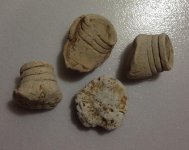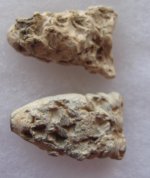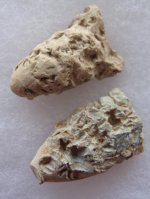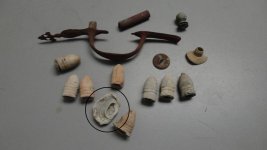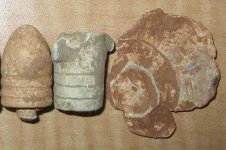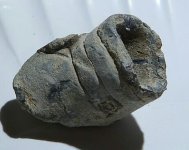You are using an out of date browser. It may not display this or other websites correctly.
You should upgrade or use an alternative browser.
You should upgrade or use an alternative browser.
High Impact Bullets! (And the Chewed Minieball Question)
- Thread starter DIRT DOBBER
- Start date
fingerlakes119
Senior Member
nice relics, looks like they bounced off of a few things
DIRT DOBBER
Forum Supporter
On a related note, besides the impact bullets, and the carved bullets, another cool Minieball find is the proverbial 'Pain Bullet'.
These two were found behind the Confederate line at the Battle of Stones River.
These two were found behind the Confederate line at the Battle of Stones River.
Attachments
Last edited:
Trickworm
Elite Member
Redfishtony
Junior Member
Pain Bullet
Never had the opportunity to find any CW relics yet but looking at the teeth marks in those bullets makes it very real what these solders went through. Looking at the others is there a way to tell what they impacted. Flesh, trees,the ground etc... Hopefully I will gain access to some sites where we can find some of these. Nice examples.
Never had the opportunity to find any CW relics yet but looking at the teeth marks in those bullets makes it very real what these solders went through. Looking at the others is there a way to tell what they impacted. Flesh, trees,the ground etc... Hopefully I will gain access to some sites where we can find some of these. Nice examples.
Spectra1
Elite Member
I can't tell if it round... Could it be a Williams cleaner piece? Idk why thy would have stuffed buck in there. But maybe the loaded some shot too.I used to get freaked out as a kid when I would find those, always made me think of what it possibly hit. I would keep all the drops, but left all those because all I could think of was some poor soldier died. I just couldnt even imagine fighting in that war.
great finds all, especially love the mid air collision one.
what is in the one in the middle of this pic, I had heard they would put small shot behind the miniball, but have never seen one lodged like that. Is that what it is?
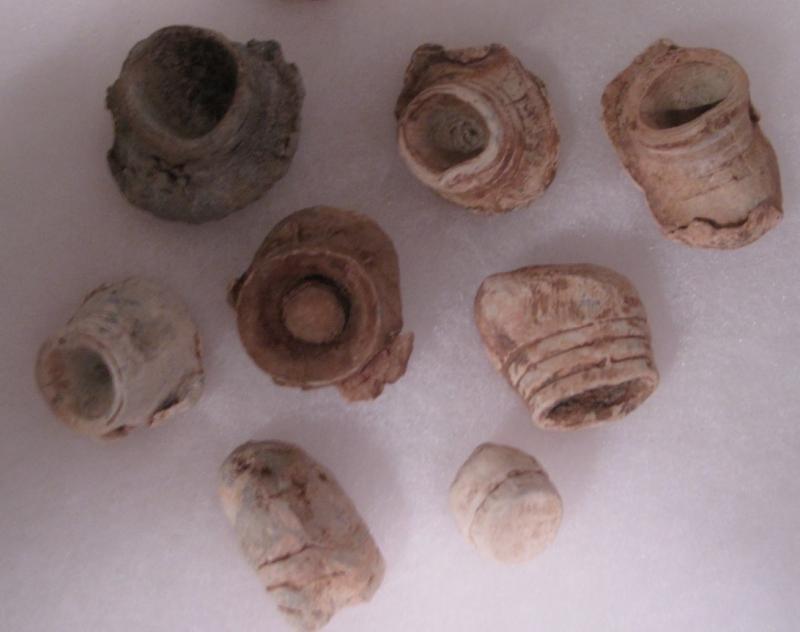
gtoast99
Forum Supporter
What a cool idea for a thread! Here's my most smooshed out bullet. Found at the Spillman Farm, DIV XXI.
Great bullets everyone! I really like the collision bullet and the impacted Washington Arsenal above. Way cool!
As for the pain bullets, there's a lot of controversy about their origin. I would encourage you to google "pain bullet myth" or something similar and decide for yourself.
Great bullets everyone! I really like the collision bullet and the impacted Washington Arsenal above. Way cool!
As for the pain bullets, there's a lot of controversy about their origin. I would encourage you to google "pain bullet myth" or something similar and decide for yourself.
Attachments
DIRT DOBBER
Forum Supporter
Thanks for mentioning that piece. I've forgotten about that one being interesting......I can't tell by looking at it whether it's just the odd way it impacted or if it's a buckn'ball that was purposely lodged behind it. The minieball has no rings. Can't id the bullet.
DIRT DOBBER
Forum Supporter
As for the pain bullets, there's a lot of controversy about their origin. I would encourage you to google "pain bullet myth" or something similar and decide for yourself.
I think that the 'pain bullets are a myth' theory is an example of contrarian bombast. I think it's just easy fodder for folks who like to disprove anecdotal theories with the old 'there's no empirical evidence to prove....'. Especially in situations where there wouldn't be evidence as a practical matter.
1. People have put things between their teeth to clamp down on to alleviate the abrupt pain of surgery or for a toothache as recorded as early as the early Roman era.
2. Lead is malleable and a logical choice for a soldier/surgeon who's looking for something easily accessable and that is malleable and would not injure teeth.
3. I've found many chewed minieballs on large battlefields, rarely near the line, mostly in the rear and always lumped together. When I found one, I usually eventually found two or three in close proximity, suggesting an area where minieballs were more likely to be chewed rather than a random dispersal such as you would find if chewing minieballs was 'habit'. However, if I was shot with a minieball and laying there waiting for a surgeon's mate to come pick me up from the battlefield I'd be chewing on what I had, which would have been a minieball.....
I think though there are many reasons that could explain minieballs that look like discarded bubblegum, and there are probably several different reasons one might chew minieballs, in the absence of evidence, I prefer to apply Occam's Razor to this sort of question......
Anyway, I could be wrong, just one man's opinion....
Last edited:
DIRT DOBBER
Forum Supporter
Hate to think some of those shot some of us Yankees !!!
I'll take the bait. I'm always up for it Rick.
You can blame that fascist Lincoln if they did......

1981Eagle
Full Member
DIGGER27
In Memory Of
gtoast99
Forum Supporter
Well, I was trying to let folks do their own research into the pain-bullet myth so as not to derail the thread. But since we're already here...
Well, I'd say the more bombastic position would be trying to make something more important than it actually is, specifically without evidence. It's pretty common in this hobby, particularly when we're first starting out. Every piece of unidentifiable iron dates to the earliest possible occupation of the site, every length of pipe is a gun barrel, every bit of horse tack is a colonial sword hanger (couldn't resist!), every coin was dropped the day it was minted, everything found remotely near a camp belonged to a soldier, every flat button was worn by a Confederate, everything with an eagle on it was military issue, every horseshoe and pocket knife was made in the 1860's, and yes - every bit of chewed up lead was clearly mangled in the mouth of a dying man in the throws of agony during a surgery (and yet miraculously not swallowed). I've been guilty of most of these at one time or another, trying to see something monumental in what amounts to a relatively less-than-monumental find.
It's not disproving an anecdotal theory to call "pain bullets" a myth, because there aren't any anecdotes to support the theory. Despite the incredible amount of writing during the era, there aren't any anecdotes about the use of bullets chewed on to relieve pain. Rather, it is disproving the wishful thinking of those who want that mangled bit of lead to be more than just a mangled bit of lead.
The fact of the matter is, we don't know what caused it to become a mangled bit of lead. It's generally thought that the most likely cause of these bullets is wild or domestic hogs. There are probably a few out there that were chewed to induce salivation (there are a couple of accounts in the plethora of writing during the era that do mention this) or out of sheer boredom in camp. As much as we may want "our" chewed up bullet to have been from the soldier, we'll never know if any specific bullet comes from animals or humans.
But what we do know, is that it most probably wasn't used to relieve pain during a surgery. For one thing, despite common misconceptions, anesthetic was pretty common during the war and would have been the primary method of pain relief during surgery. Furthermore, while there are no "anecdotes" from the time period suggesting that a bullet would have been chewed during surgery, there are plenty of period medical textbooks which *specifically* mention not using anything in the mouth during surgery, particularly anything which has the possibility of aspiration.
Oh, and one last bit of "anecdotal" evidence for you. I once got to detect the Battle of Alamance with the NC office of state archeology. This War of Regulation battle saw less than 40 killed. And yet, a very large number of the musket balls we found showed considerable chewing. It's highly unlikely that the area of the battle was a giant field hospital (given the low number of casualties) with everyone chewing up bullets left and right. But you know what was there, after the war? A hog farm. Just sayin.
NOW, on to more high impact bullets!!
I think that the 'pain bullets are a myth' theory is an example of contrarian bombast. I think
...
Anyway, I could be wrong, just one man's opinion....
Well, I'd say the more bombastic position would be trying to make something more important than it actually is, specifically without evidence. It's pretty common in this hobby, particularly when we're first starting out. Every piece of unidentifiable iron dates to the earliest possible occupation of the site, every length of pipe is a gun barrel, every bit of horse tack is a colonial sword hanger (couldn't resist!), every coin was dropped the day it was minted, everything found remotely near a camp belonged to a soldier, every flat button was worn by a Confederate, everything with an eagle on it was military issue, every horseshoe and pocket knife was made in the 1860's, and yes - every bit of chewed up lead was clearly mangled in the mouth of a dying man in the throws of agony during a surgery (and yet miraculously not swallowed). I've been guilty of most of these at one time or another, trying to see something monumental in what amounts to a relatively less-than-monumental find.
It's not disproving an anecdotal theory to call "pain bullets" a myth, because there aren't any anecdotes to support the theory. Despite the incredible amount of writing during the era, there aren't any anecdotes about the use of bullets chewed on to relieve pain. Rather, it is disproving the wishful thinking of those who want that mangled bit of lead to be more than just a mangled bit of lead.
The fact of the matter is, we don't know what caused it to become a mangled bit of lead. It's generally thought that the most likely cause of these bullets is wild or domestic hogs. There are probably a few out there that were chewed to induce salivation (there are a couple of accounts in the plethora of writing during the era that do mention this) or out of sheer boredom in camp. As much as we may want "our" chewed up bullet to have been from the soldier, we'll never know if any specific bullet comes from animals or humans.
But what we do know, is that it most probably wasn't used to relieve pain during a surgery. For one thing, despite common misconceptions, anesthetic was pretty common during the war and would have been the primary method of pain relief during surgery. Furthermore, while there are no "anecdotes" from the time period suggesting that a bullet would have been chewed during surgery, there are plenty of period medical textbooks which *specifically* mention not using anything in the mouth during surgery, particularly anything which has the possibility of aspiration.
Oh, and one last bit of "anecdotal" evidence for you. I once got to detect the Battle of Alamance with the NC office of state archeology. This War of Regulation battle saw less than 40 killed. And yet, a very large number of the musket balls we found showed considerable chewing. It's highly unlikely that the area of the battle was a giant field hospital (given the low number of casualties) with everyone chewing up bullets left and right. But you know what was there, after the war? A hog farm. Just sayin.
NOW, on to more high impact bullets!!
DIRT DOBBER
Forum Supporter
Oh, and one last bit of "anecdotal" evidence for you. I once got to detect the Battle of Alamance with the NC office of state archeology. This War of Regulation battle saw less than 40 killed. And But you know what was there, after the war? A hog farm. Just sayin.
NOW, on to more high impact bullets!!
Sounds like you have a personal interest here by your tone. But thanks for the reply. Before going 'back to more high impact bullets' as per your instructions, ill note, outside the bombast, your argument boiled down to "We dont know"....youre exactly who I was talking about.
I'll also note you describe these as "mangled bits of lead". Let's clarify that they are mangled bits of lead, "mangled by teeth", so we don't give the impression were talking about any old piece of lead.
Also, as it happens, I raise hogs, and though they love to pick things up and chew them they don't chew them gently, or over and over, they bite hard, once or twice, like they do with fresh nuts, etc. until they realize it's not food. (you can hear a hog crack rocks for hundreds of yards) And their molars cut the soft lead in half in a chew or two. I can assure you a hog didn't chew any of those minieballs. Ill send pics of hog chewed minieballs if you'd like.
As to pain control in the civil war ill just say the confederate army barely had shoes in the second half of the war., though it's true there were other common means of pain relief/retardation.
Good job on your work for the government. Sounded real impressive there at the end. Nice touch.
All that being said, we don't know they are pain bullets. True. But they were chewed. By people. For one reason or another.
HH
Last edited:
gtoast99
Forum Supporter
No personal interest, besides trying to get the most accurate information possible. I knew you'd have some version of passive aggressive retort. So I won't other indulging you any more, save for posting the opinion of George Wunderlich, Executive Director of the Museum of Civil War Medicine, who does wonders to put this myth to rest. I'd say that's a pretty credible source, but hey, what does he know, right?
Most experts disagree with the concept of "pain bullets", believing the vast majority to be hog chewed. Of course, you can say they were chewed on by Martians if you'd like, they're you're bullets.
Most experts disagree with the concept of "pain bullets", believing the vast majority to be hog chewed. Of course, you can say they were chewed on by Martians if you'd like, they're you're bullets.
DIRT DOBBER
Forum Supporter
No personal interest, besides trying to get the most accurate information possible. I knew you'd have some version of passive aggressive retort. So I won't other indulging you any more, save for posting the opinion of George Wunderlich, Executive Director of the Museum of Civil War Medicine, who does wonders to put this myth to rest. I'd say that's a pretty credible source, but hey, what does he know, right?
Most experts disagree with the concept of "pain bullets", believing the vast majority to be hog chewed. Of course, you can say they were chewed on by Martians if you'd like, they're you're bullets.
Let's admit both your posts were incredibly passive aggressive themselves. Which makes that comment oddly disconcerting.
"Indulging me". Now that wins the title of 'most condescending'. Congrats. Lol.
Look, people who think current scientific consensus represents 'truth' are little different than those who think truth only comes from holy books. We all get to have our opinion while a question is unproven. Calling something myth doesn't make it so.
I think they're chewed to relieve discomfort or pain, but if they're not, 'pain bullets' is a pretty good name for them, and no one's lost any skin over it all. The truth is there's probably chewed bullets to be found for all the reasons stated in all our posts and what we're really arguing about the origin of a 'majority' of chewed bullets in which case the easy to toss around 'myth' wouldn't apply because we are arguing percentages.
Very interesting vid. Thanks.
Last edited:
Wow I hate to plunge in here but after reading Gtoast long empty post . ( being nice ) and seeing the vid , I have to ask . Would Leads chewed on after a operation be considered pain bullets? How can they use the term myth?
My intrest in CW bullets began after seeing them for sale at a antique mall 3- for $5 dollars. I learned about the impact they made on war because of the damage they do to the body , the use of snipers and carved bullets . That's why I love this forum, what can learn from discussion.
Thanks everyone for posting your pics so we learn more about the life of CW soldiers .
Oh yeah the myth , as I see it is that you can get in front of a vid camera and state you know everything that happened during the CW . After all we just go to Walgreens get pain pills . Why chew lead?
HH
My intrest in CW bullets began after seeing them for sale at a antique mall 3- for $5 dollars. I learned about the impact they made on war because of the damage they do to the body , the use of snipers and carved bullets . That's why I love this forum, what can learn from discussion.
Thanks everyone for posting your pics so we learn more about the life of CW soldiers .
Oh yeah the myth , as I see it is that you can get in front of a vid camera and state you know everything that happened during the CW . After all we just go to Walgreens get pain pills . Why chew lead?
HH
Dirtdiggenfool
Forum Supporter
I don't have but two impacted minnie balls,but one is weird.


Dirtdiggenfool
Forum Supporter
I was told onetime back in the 70's that the minnie ball's that are chewed because they chewed on them when they went in to battle because of being scared.


